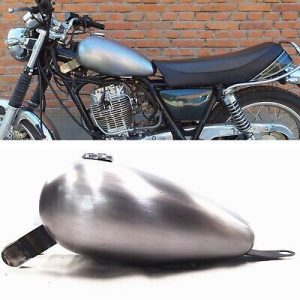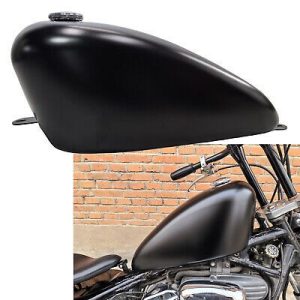Keeping your motorcycle in top shape is a must for every rider. A clean gas tank is crucial for optimal performance and preventing future problems. But how do you tackle a dirty or rusty gas tank? Fear not, fellow enthusiasts! This comprehensive guide will equip you with the knowledge and steps to effectively clean your motorcycle gas tank, ensuring a smooth ride for miles to come.
Why Clean Your Motorcycle Gas Tank?
You might be wondering why cleaning your gas tank is so important. Here’s a breakdown of the key benefits:

- Prevents Performance Issues: Dirt, debris, and rust can clog fuel filters and injectors, leading to engine sputtering, hesitation, and decreased power. A clean tank ensures a smooth flow of clean fuel for optimal performance.
- Extends Motorcycle Lifespan: Rust is the enemy of metal. Left unchecked, rust can eat away at your gas tank, leading to leaks and potential fuel system damage. Regular cleaning helps prevent rust and extends the lifespan of your motorcycle.
- Improves Fuel Efficiency: A clogged tank can restrict fuel flow, forcing your engine to work harder. Cleaning the tank allows fuel to flow freely, promoting better fuel efficiency and saving you money at the pump.
- Maintains Resale Value: A clean and well-maintained gas tank reflects a motorcycle that’s been cared for. This can significantly boost your motorcycle’s resale value when the time comes to upgrade.
Assessing Your Gas Tank
Before diving into the cleaning process, it’s crucial to assess the condition of your gas tank. Here’s how:

- Visual Inspection: Remove the gas tank from your motorcycle and visually inspect the inside. Look for signs of rust, debris, varnish buildup, or any other contaminants.
- Swishing Test: Partially fill the tank with clean water and shake it vigorously. Listen for any rattling sounds, which could indicate loose debris or rust flakes.
- Magnet Test: Use a strong magnet to check the tank walls. If the magnet sticks readily, it’s a strong indicator of significant rust buildup.
Based on your assessment, you can choose the most appropriate cleaning method for your needs.
Choosing the Right Cleaning Method
There are several effective methods for cleaning a motorcycle gas tank, each with its own advantages and limitations. Here’s a breakdown of the most common methods:
- Vinegar & Baking Soda: This is a safe and readily available option for mild rust and debris. White vinegar’s mild acidity loosens rust, while baking soda neutralizes the vinegar and acts as a mild abrasive.
- Commercial Tank Cleaners: Several commercial tank cleaners are specifically formulated for motorcycle gas tanks. These cleaners are often more potent than vinegar and can tackle tougher jobs, but ensure they’re compatible with your tank material.
- Media Blasting: This method involves blasting the tank interior with a stream of abrasive media like walnut shells or glass beads. It’s a highly effective method for removing heavy rust and varnish buildup, but requires specialized equipment and should be done by a professional.
Step-by-Step Guide to Cleaning Your Motorcycle Gas Tank (Vinegar & Baking Soda Method)
If you’ve assessed your tank and determined mild rust or debris is present, the vinegar and baking soda method is a great option. Here’s a step-by-step guide:

Instructions:
-
Preparation: Work in a well-ventilated area. Wear safety goggles and gloves to protect yourself from fumes and chemicals. Remove the gas tank from your motorcycle following your motorcycle’s service manual instructions. Drain any remaining fuel into a suitable container approved for gasoline storage.
-
Initial Cleaning: Pour a small amount of dish soap and warm water into the tank. Swish it around to loosen any debris or dirt clinging to the interior walls. Drain the soapy water into your bucket.
-
Vinegar Bath: Fill the tank with enough white vinegar to completely submerge the interior. You can use a funnel to aid this process. If there’s significant rust, heat the vinegar slightly (not boiling) to increase its effectiveness.
-
Baking Soda Bonanza: Once the tank is filled with vinegar, slowly add baking soda. A fizzing reaction will occur, indicating the baking soda is neutralizing the vinegar and aiding in the cleaning process. Let the mixture sit for 24 to 48 hours, depending on the severity of the rust.
-
Agitation is Key: For best results, periodically agitate the tank during the vinegar soak. You can shake it gently or use a long wooden stick to stir the mixture inside.
Neutralization and Rinsing
-
Neutralize the Mixture: After the designated soak time, carefully empty the vinegar and baking soda solution into your bucket. Wear gloves and eye protection while handling this mixture, as fumes can be present.

-
Water Rinse: Thoroughly rinse the tank with clean water. Use a hose with a strong stream to dislodge any loosened debris or rust flakes. Repeat the rinsing process several times until the water runs clear, indicating all traces of the vinegar-baking soda mixture are gone.
-
Dish Soap Rinse: To ensure complete neutralization, fill the tank with a solution of warm water and dish soap. Swish it around and empty it again. Repeat this rinse with clean water one final time.
Drying and Inspection
-
Drying is Crucial: Moisture left behind in the tank can lead to future rust problems. Use compressed air to blow out any remaining water droplets from the tank’s nooks and crannies. Alternatively, let the tank air dry completely for several days in a warm, well-ventilated area. You can use clean rags to absorb any remaining moisture.
-
Final Inspection: Once the tank is completely dry, perform a final visual inspection. Look for any remaining rust or debris. If some stubborn areas persist, you can repeat the vinegar and baking soda soak or consider a more aggressive cleaning method like commercial tank cleaners.
Sealing and Reassembly (Optional)
For additional protection against future rust formation, consider using a tank sealer after cleaning. There are two main types of tank sealers:

- Creme-based sealers: These are brushed onto the clean, dry tank interior and form a protective coating.
- Fuel-tank liners: These are self-adhesive liners that completely coat the tank’s interior, providing a more robust barrier against rust and corrosion.
Once the tank is completely dry and sealed (if applicable), carefully reassemble the tank on your motorcycle following your service manual instructions. Ensure all hoses, fuel lines, and connections are secure before starting the engine.
Don’t Let Rust Win!
By following these steps and choosing the right cleaning method, you can effectively clean your motorcycle gas tank and ensure a smooth ride for years to come. Remember, a clean gas tank not only improves performance and fuel efficiency but also extends the lifespan of your motorcycle and maintains its resale value. So, grab your tools, choose your cleaning method, and conquer that pesky corrosion!